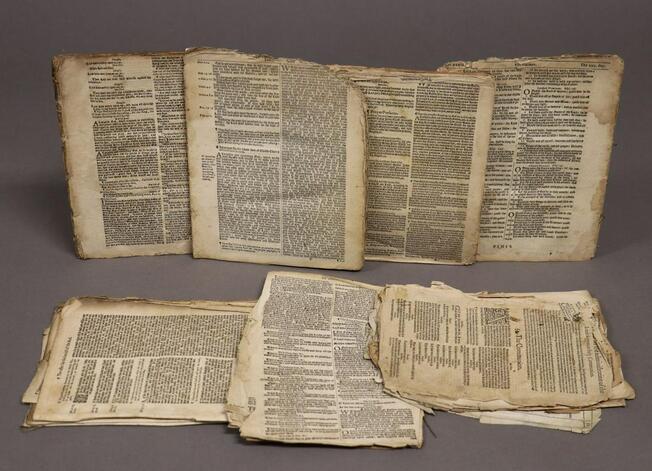Many of our historic and rare Bibles are showcased and displayed by a single framed "leaf" in the Exhibit. A "leaf" is a term which simply refers to a page or sheet from any book, Bible or manuscript. A single "leaf" therefore contains two pages which are referred to as either the "verso" and "recto" side of the "leaf" or page. More on that can be found here.
The Bible leaves in our Exhibit, were not removed from any undamaged Bibles or ancient books, but were taken from damaged fragments of these rare printings which were unable to be restored due to excessive damage, missing pages or both. These leaves are not copies or facsimiles or reproductions but are authentic, genuine originals. Most ancient Bibles and books were printed on 100% rag cotton handmade paper, referred to as "laid" paper. Until the 1750s, all true "paper" was laid paper. It was made on a mesh frame (called a Mould & Deckle) consisting of strong wires about an inch apart, with finer wires laid close together across them in a square wooden frame. This gridiron pattern can be seen when the paper is held to the light. These lines are referred to as "chain lines". Today, some writing paper is still laid, though the pattern being more of a decoration. This is one of the reasons why ancient paper has lasted for centuries. It was well-made. The 100% cotton rag paper can even withstand ironing! It wasn't until the later part of the 1750's that "wove" paper was invented. Cheaper wood-pulp paper was used starting in the 1800s and is why most paper from Bibles produced in the 1800's are more brittle and fragile than paper from the 1500's for example.
Many ancient Bibles and manuscripts were not printed on any true "paper" but rather utilized vellum or parchment. In today's day and age, "parchment paper" refers to special paper that is made from cellulose fibers prepared from fir trees or plants such as cotton or flax, but in ancient times, parchment referred to any animal skin that was prepared to use for manuscripts, scrolls, codices (books), etc. This can include calf, goat and sheep skins. Vellum is a term which specifically refers to fine calf skin. The famous Gutenberg Bible of 1455 is a good example of a vellum printing. Of the 180 total copies that were printed in 1455 by Gutenberg, about 35 were printed on vellum. The Library of Congress in Washington D.C. has one of the ultra-rare vellum copies on display.
In 2 Timothy 4:13, the Apostle Paul wrote, "When you come, bring the warm coat I left with Carpus in the city of Troas. Also bring the scrolls and especially the parchments." (GW) We get this word "parchment" from the Greek word "μεμβράνα" which is transliterated as " membrana " (mem-bran'-ah), or "membrane" as we know it today.
By showcasing many of our rare Bibles in our Exhibit through the utilization of single leaf displays, attendees of The Bible Exhibit are able to interact with these items up-close. By displaying the leaves in double-sided acrylic display frames, many can be held, examined, read and studied by the attendees. In a traditional museum experience, visitors are not allowed to interact with the items on display. They cannot open, touch, read, or turn the page of the items on display. As a matter of fact, they often can't get within several feet of any given item which are oftentimes dimly-lit and encased in large security cases. Our exhibits allow for personal interaction with a good portion of our framed leaves, which we feel we give our attendees a more personal, rewarding and memorable experience.
Come experience The Bible Exhibit for yourself at our next event, or contact us today to schedule an event at your local church or church event!
Many ancient Bibles and manuscripts were not printed on any true "paper" but rather utilized vellum or parchment. In today's day and age, "parchment paper" refers to special paper that is made from cellulose fibers prepared from fir trees or plants such as cotton or flax, but in ancient times, parchment referred to any animal skin that was prepared to use for manuscripts, scrolls, codices (books), etc. This can include calf, goat and sheep skins. Vellum is a term which specifically refers to fine calf skin. The famous Gutenberg Bible of 1455 is a good example of a vellum printing. Of the 180 total copies that were printed in 1455 by Gutenberg, about 35 were printed on vellum. The Library of Congress in Washington D.C. has one of the ultra-rare vellum copies on display.
In 2 Timothy 4:13, the Apostle Paul wrote, "When you come, bring the warm coat I left with Carpus in the city of Troas. Also bring the scrolls and especially the parchments." (GW) We get this word "parchment" from the Greek word "μεμβράνα" which is transliterated as " membrana " (mem-bran'-ah), or "membrane" as we know it today.
By showcasing many of our rare Bibles in our Exhibit through the utilization of single leaf displays, attendees of The Bible Exhibit are able to interact with these items up-close. By displaying the leaves in double-sided acrylic display frames, many can be held, examined, read and studied by the attendees. In a traditional museum experience, visitors are not allowed to interact with the items on display. They cannot open, touch, read, or turn the page of the items on display. As a matter of fact, they often can't get within several feet of any given item which are oftentimes dimly-lit and encased in large security cases. Our exhibits allow for personal interaction with a good portion of our framed leaves, which we feel we give our attendees a more personal, rewarding and memorable experience.
Come experience The Bible Exhibit for yourself at our next event, or contact us today to schedule an event at your local church or church event!
